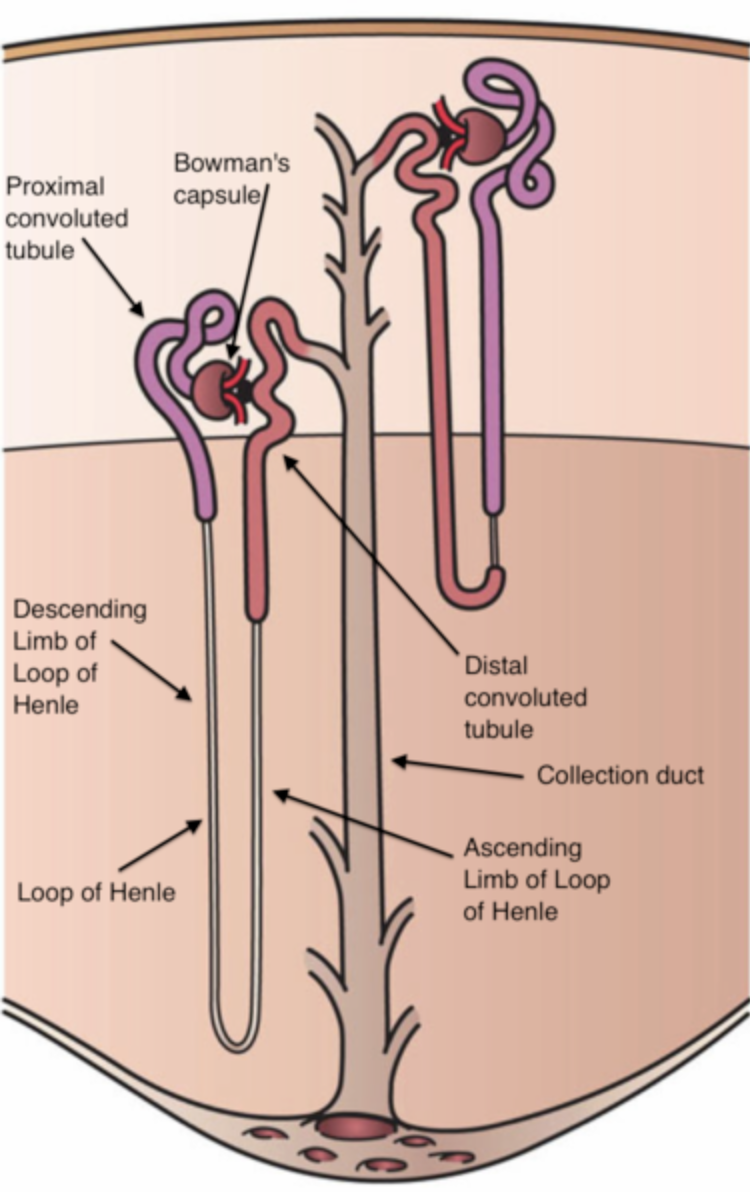
The mechanism of uric acid excretion in a nephron is
(a) Osmosis
(b) Diffusion
(c) Secretion
(d) Ultrafiltration
Answer
480.3k+ views
1 likes
Hint: Uric acid is something that is not required by the body and is present in an excess amount that is the required quantity. Such substances are excreted in a nephron by the process which also removes potassium ions
Complete Answer:
The mechanism of uric acid excretion in a nephron is tubular secretion. This process is done by the proximal convoluted tubule (PCT) and distal convoluted tubule (DCT) where certain substances are actively secreted out in the urine through the expenditure of energy. This helps to maintain the pH of the blood. The substances that are actively secreted out from the body include
Additional information: Let us look at the mechanism of urine formation. It involves three main processes which are:
Glomerular filtration: This is the first step in urine formation in which blood coming through the glomerulus is filtered out. On average, 1100-1200 mL of blood is filtered out in a minute by the kidneys. It is considered a process of ultrafiltration because blood is filtered very finely through the layers of the epithelium of blood vessels and Bowman’s capsule that all the content of the plasma is passed through except for proteins.

Reabsorption: The kidneys have a built-in mechanism through which they absorb 99% of the filtrate that was produced through the process of glomerular filtration. One such mechanism is the juxtaglomerular apparatus (JGA). The kidneys are so efficient in reabsorbing that only 1.5 L of urine is released out of the 180 L of filtrate formed.
Secretion: In this process, active secretion of substances takes place that is not needed by the body or is in excess amounts in the body.
So, the correct option is ‘(c) Secretion’.
Note:
- The epithelium of Bowman’s capsule has cells called podocytes that are arranged in an intricate manner to create pores called slit pores which help in glomerular filtration.
- Substances like glucose, amino acids etc are reabsorbed actively whereas nitrogenous wastes are reabsorbed passively.
- In the initial segments of the nephron, passive reabsorption of water takes place.
Complete Answer:
The mechanism of uric acid excretion in a nephron is tubular secretion. This process is done by the proximal convoluted tubule (PCT) and distal convoluted tubule (DCT) where certain substances are actively secreted out in the urine through the expenditure of energy. This helps to maintain the pH of the blood. The substances that are actively secreted out from the body include
Additional information: Let us look at the mechanism of urine formation. It involves three main processes which are:
Glomerular filtration: This is the first step in urine formation in which blood coming through the glomerulus is filtered out. On average, 1100-1200 mL of blood is filtered out in a minute by the kidneys. It is considered a process of ultrafiltration because blood is filtered very finely through the layers of the epithelium of blood vessels and Bowman’s capsule that all the content of the plasma is passed through except for proteins.

Reabsorption: The kidneys have a built-in mechanism through which they absorb 99% of the filtrate that was produced through the process of glomerular filtration. One such mechanism is the juxtaglomerular apparatus (JGA). The kidneys are so efficient in reabsorbing that only 1.5 L of urine is released out of the 180 L of filtrate formed.
Secretion: In this process, active secretion of substances takes place that is not needed by the body or is in excess amounts in the body.
So, the correct option is ‘(c) Secretion’.
Note:
- The epithelium of Bowman’s capsule has cells called podocytes that are arranged in an intricate manner to create pores called slit pores which help in glomerular filtration.
- Substances like glucose, amino acids etc are reabsorbed actively whereas nitrogenous wastes are reabsorbed passively.
- In the initial segments of the nephron, passive reabsorption of water takes place.
Recently Updated Pages
Express the following as a fraction and simplify a class 7 maths CBSE

The length and width of a rectangle are in ratio of class 7 maths CBSE

The ratio of the income to the expenditure of a family class 7 maths CBSE

How do you write 025 million in scientific notatio class 7 maths CBSE

How do you convert 295 meters per second to kilometers class 7 maths CBSE

Write the following in Roman numerals 25819 class 7 maths CBSE

Trending doubts
State and prove Bernoullis theorem class 11 physics CBSE

What are Quantum numbers Explain the quantum number class 11 chemistry CBSE

Write the differences between monocot plants and dicot class 11 biology CBSE

1 ton equals to A 100 kg B 1000 kg C 10 kg D 10000 class 11 physics CBSE

State the laws of reflection of light

In northern hemisphere 21st March is called as A Vernal class 11 social science CBSE




